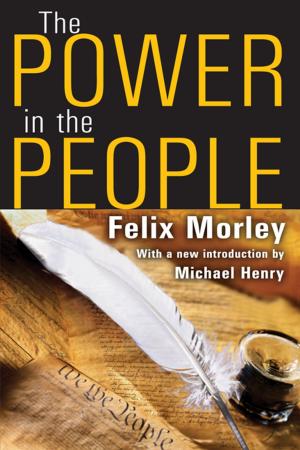Searchers, Seers, and Shakers
Masters of Social Science
Nonfiction, Social & Cultural Studies, Social Science, Sociology| Author: | James A. Schellenberg | ISBN: | 9781351491730 |
| Publisher: | Taylor and Francis | Publication: | July 28, 2017 |
| Imprint: | Routledge | Language: | English |
| Author: | James A. Schellenberg |
| ISBN: | 9781351491730 |
| Publisher: | Taylor and Francis |
| Publication: | July 28, 2017 |
| Imprint: | Routledge |
| Language: | English |
This volume offers intellectual portraits of eleven giants of the modern social sciences. It is bound by two central themes. The first is that there is a fundamental unity behind the various forms of social science. There is a general social science as well as a variety of social science disciplines. The second theme is that a biographical approach is a useful tool for making clear some of the central ideas of social science. By looking at the lives and achievements of selected masters, we should be better able to understand the fundamental nature (or natures) of social science.In order to determine which figures should be regarded as masters Schellenberg defines the three main kinds of work he sees as central for social science. First is the work of basic discovery done by searchers who made especially important contributions to empirical work in the social sciences. The persons he selected for special treatment here are Louis Leakey, Mary Leakey, Margaret Mead, and B. F. Skinner. He then considers the work of theory, choosing for examination seers who had made especially important theoretical contributions: John Dewey, Talcott Parsons, and Kenneth Boulding.Schellenberg next examines those social scientists who worked to seek changes in society. These were the shakers or social reformers. In Schellenberg's view these come in three main subtypes, and he sought to include at least one example of each--Gunnar Myrdal and Alva Myrdal as social engineers, C. Wright Mills as a rebellious social critic, and Daniel Patrick Moynihan as one whose contribution was made more directly into the world of politics.Schellenberg's exploration of the lives of these eleven masters of twentieth-century social science reveals many surprises and ironies. While he points out major contributions, he also has felt free to make criticisms. As he has said: These were all real persons, with failings and foibles, as well as persons of great achievement. I felt that the examination of
This volume offers intellectual portraits of eleven giants of the modern social sciences. It is bound by two central themes. The first is that there is a fundamental unity behind the various forms of social science. There is a general social science as well as a variety of social science disciplines. The second theme is that a biographical approach is a useful tool for making clear some of the central ideas of social science. By looking at the lives and achievements of selected masters, we should be better able to understand the fundamental nature (or natures) of social science.In order to determine which figures should be regarded as masters Schellenberg defines the three main kinds of work he sees as central for social science. First is the work of basic discovery done by searchers who made especially important contributions to empirical work in the social sciences. The persons he selected for special treatment here are Louis Leakey, Mary Leakey, Margaret Mead, and B. F. Skinner. He then considers the work of theory, choosing for examination seers who had made especially important theoretical contributions: John Dewey, Talcott Parsons, and Kenneth Boulding.Schellenberg next examines those social scientists who worked to seek changes in society. These were the shakers or social reformers. In Schellenberg's view these come in three main subtypes, and he sought to include at least one example of each--Gunnar Myrdal and Alva Myrdal as social engineers, C. Wright Mills as a rebellious social critic, and Daniel Patrick Moynihan as one whose contribution was made more directly into the world of politics.Schellenberg's exploration of the lives of these eleven masters of twentieth-century social science reveals many surprises and ironies. While he points out major contributions, he also has felt free to make criticisms. As he has said: These were all real persons, with failings and foibles, as well as persons of great achievement. I felt that the examination of















